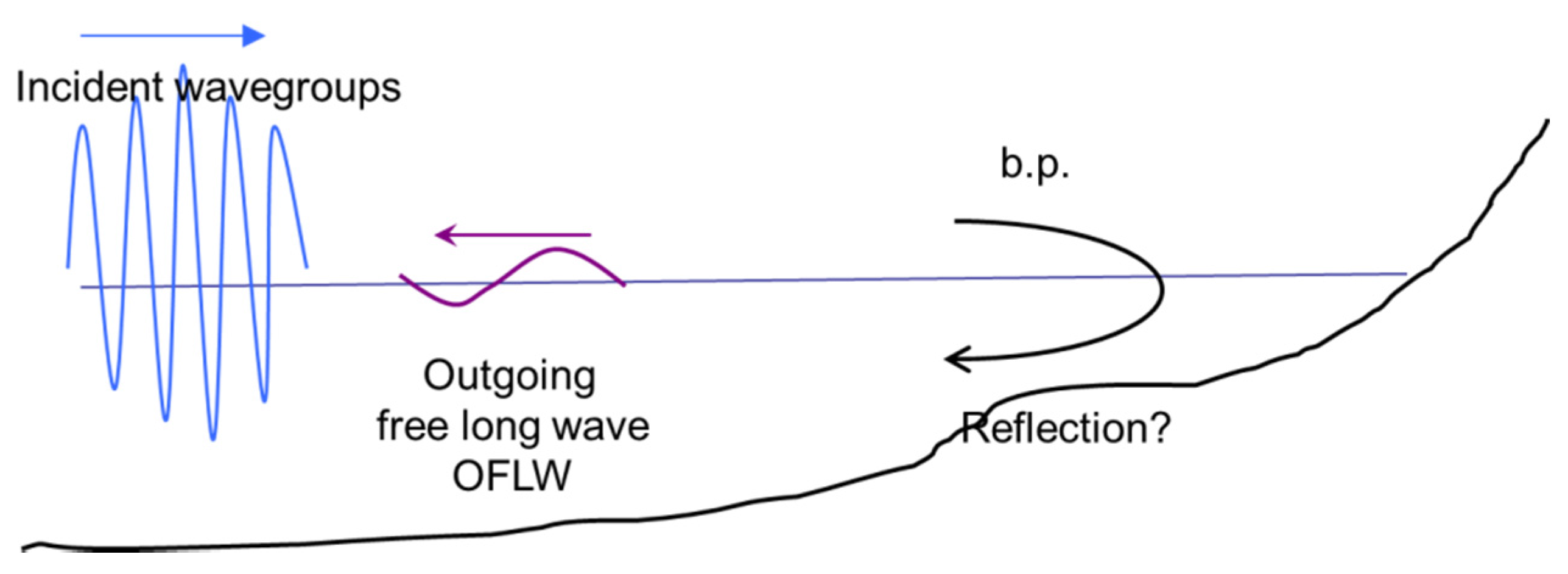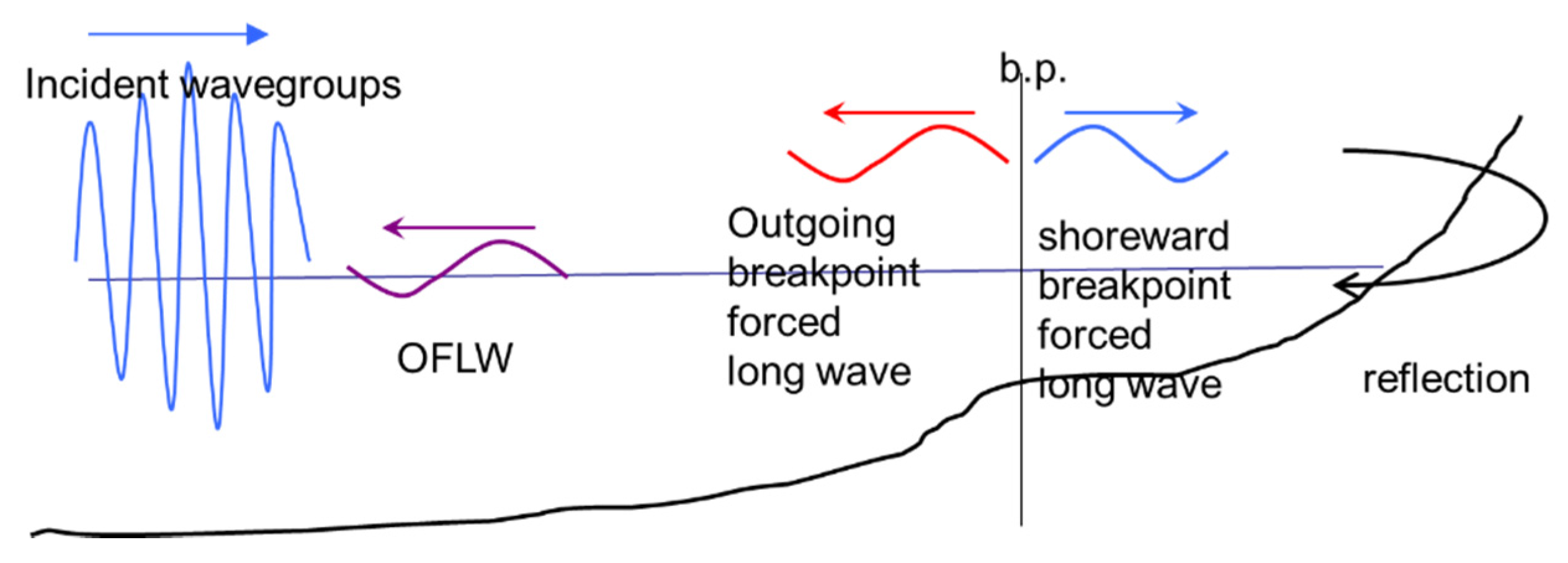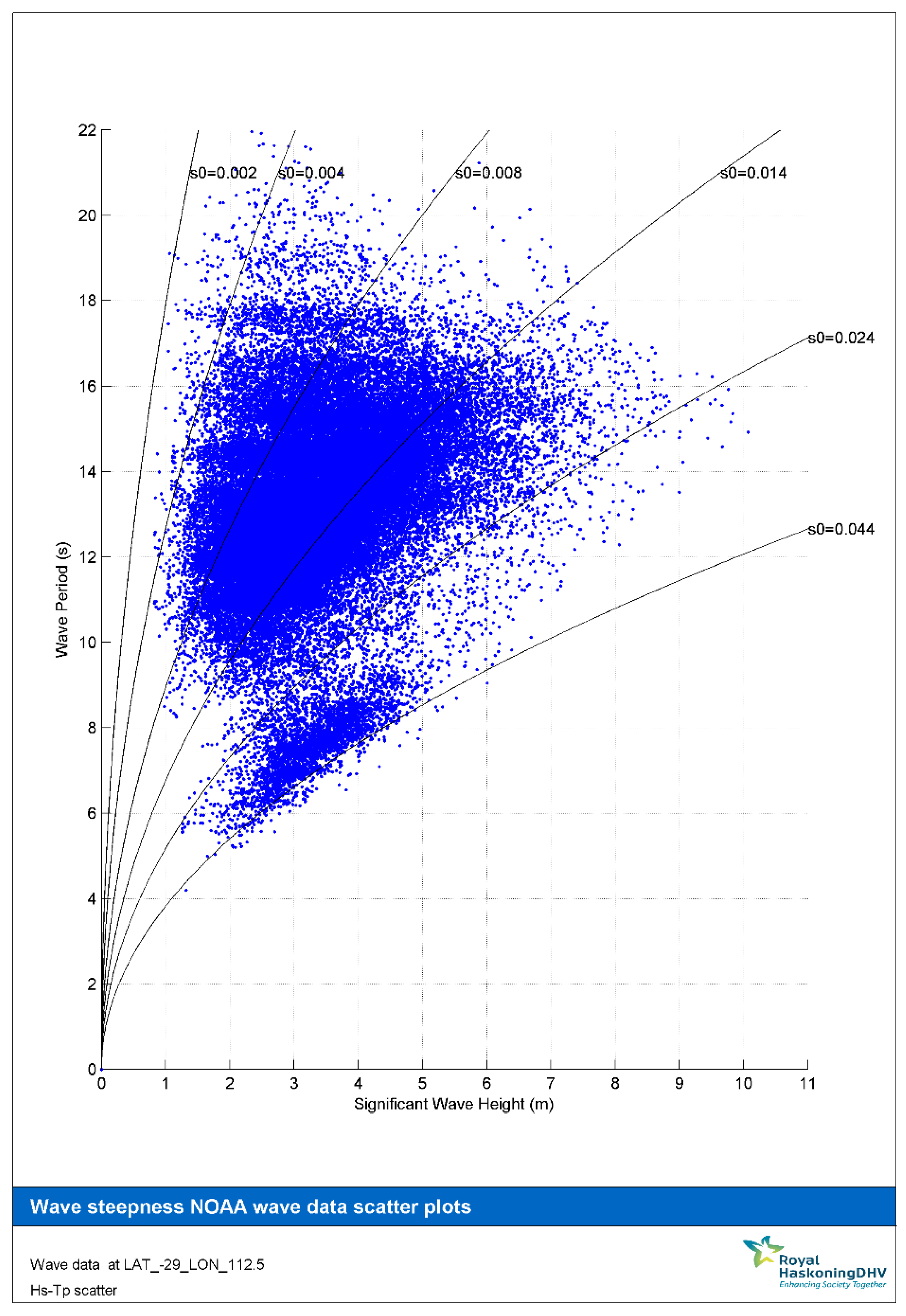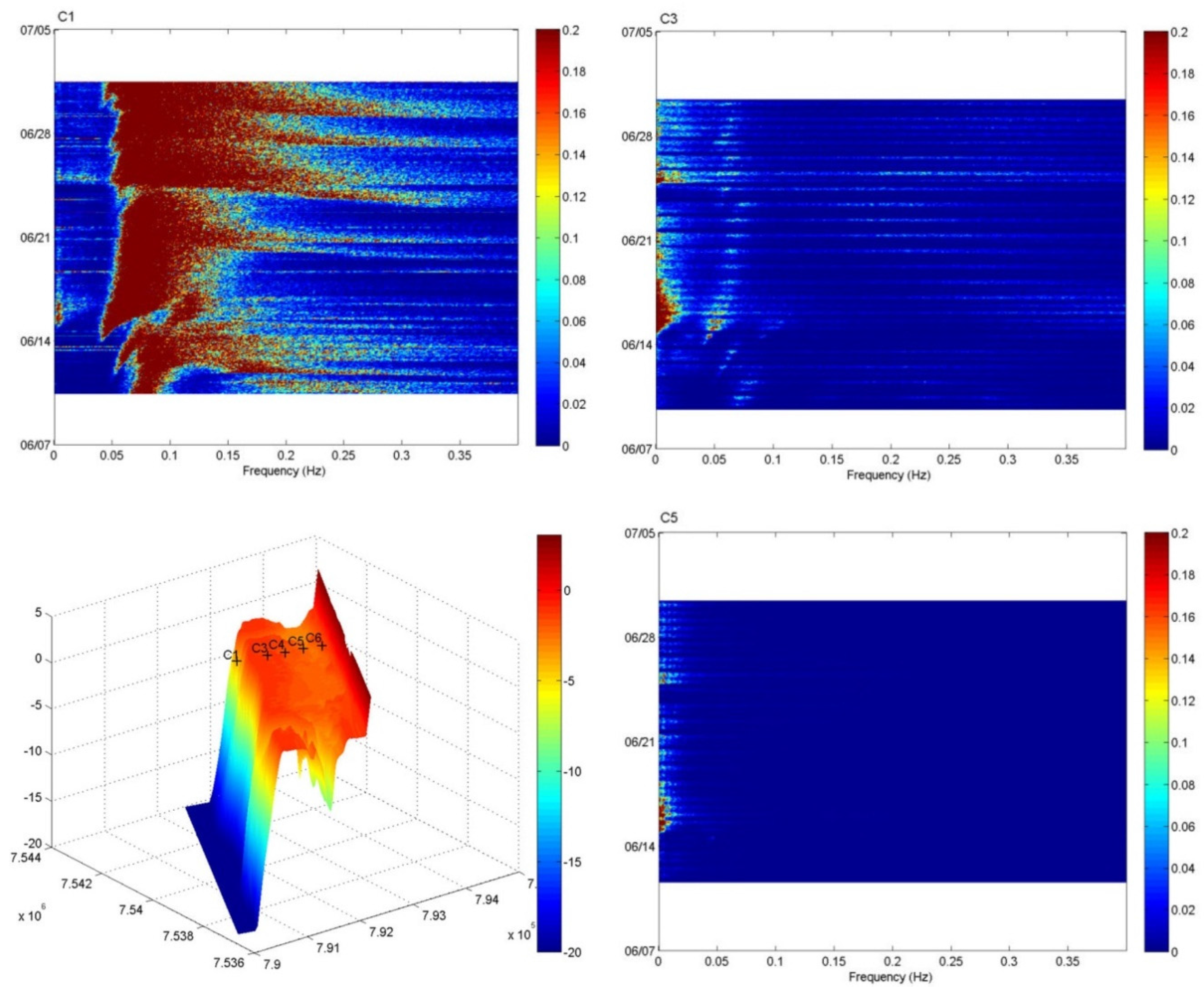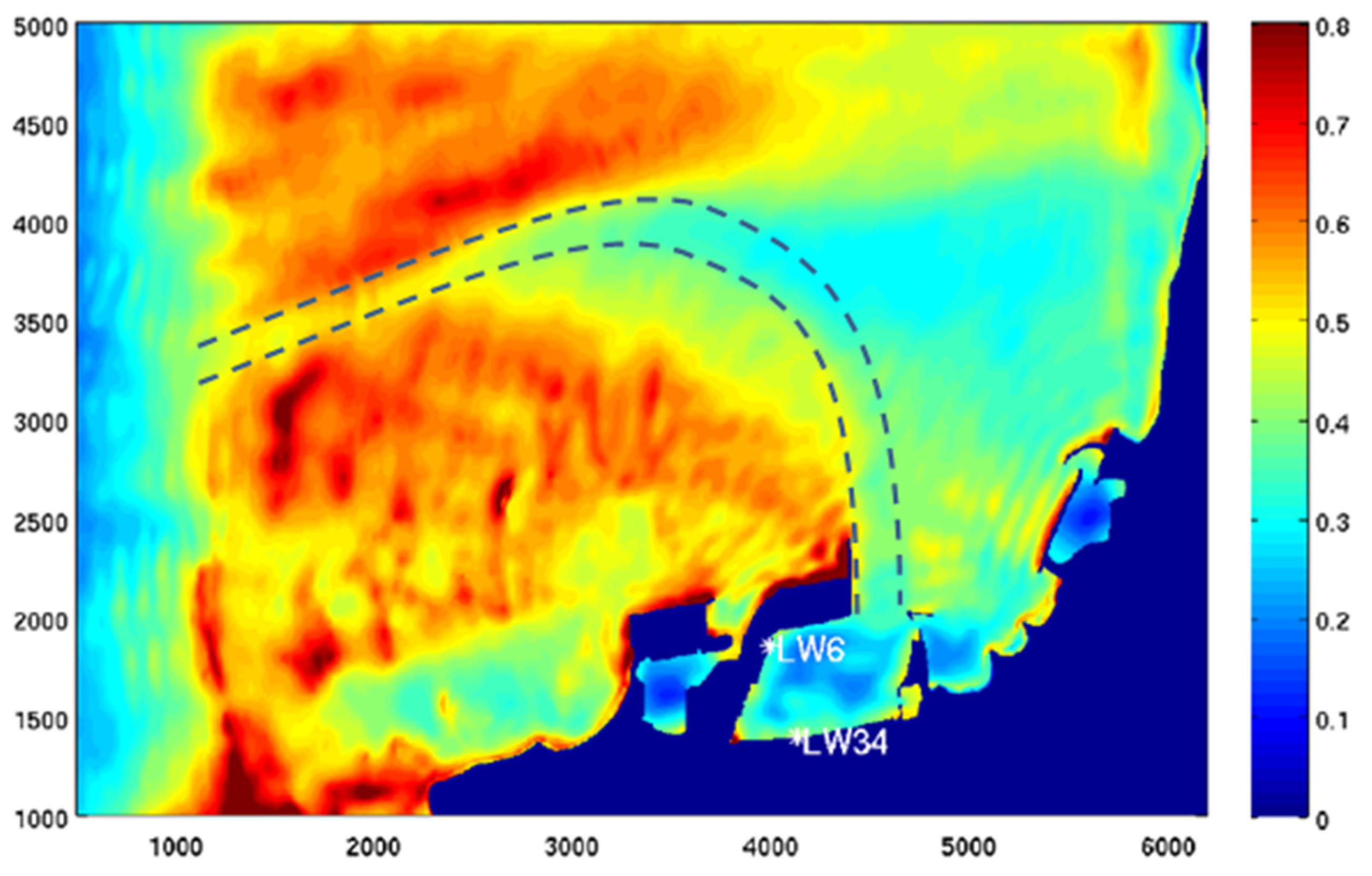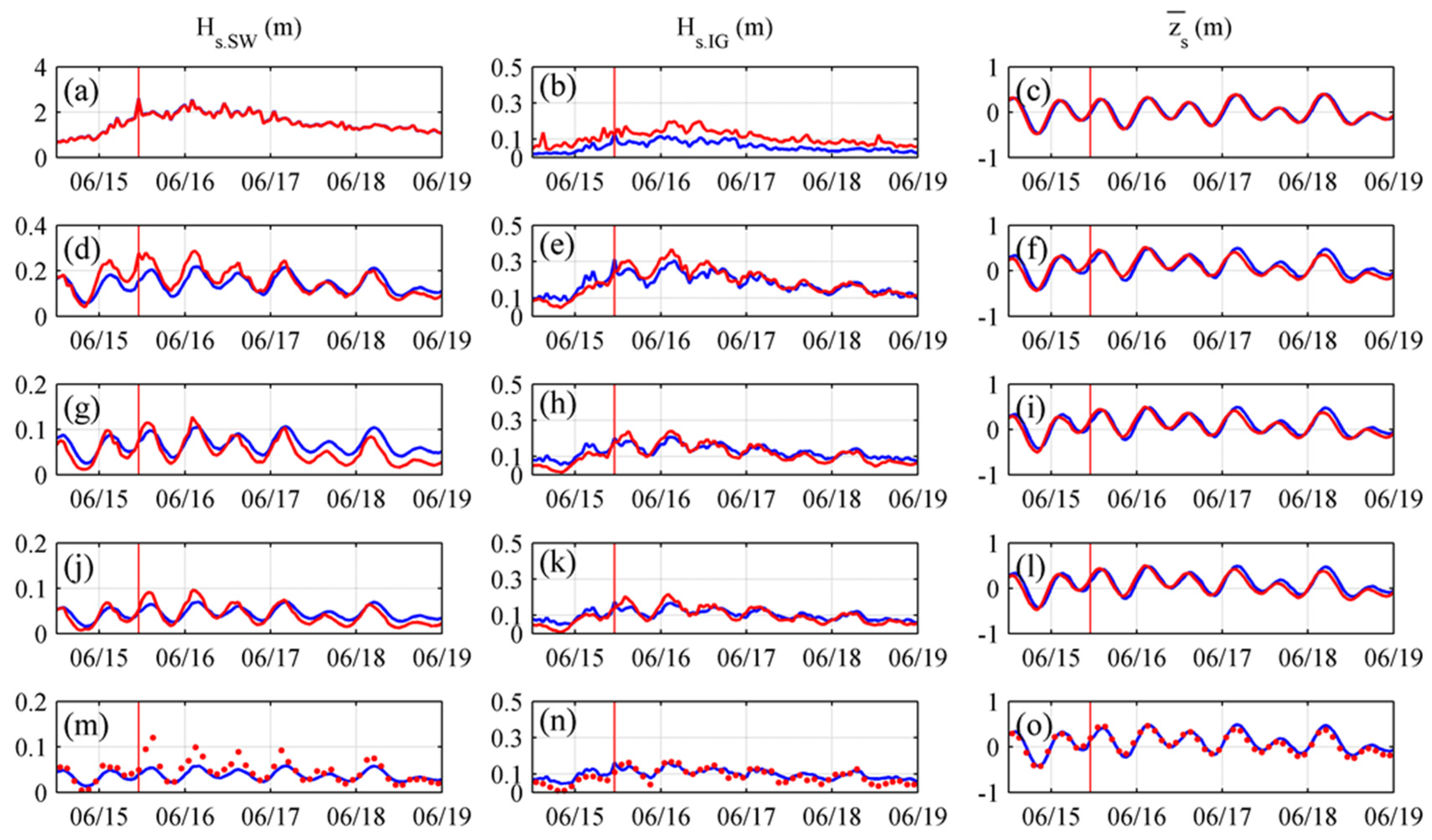1. Introduction
Long waves, sometimes also called “low frequency waves”, “infragravity waves” or “subharmonic gravity waves”, are waves that are forced in deeper water through subharmonic interactions of sea and swell wave components. Through short wave breaking on the reef edge these IG waves gain energy after which they propagate over the reef flat where they slowly decay due to bottom friction dissipation. This attenuation rate is slower than for the short waves, and thus infra-gravity waves dominate over swell waves near the coastline, and propagate into ports. Here, because of their long wave lengths, they can excite harbor seiching and ship motions, which have implications for the downtime of port operations. This operational downtime of moored vessels due to long wave activity has been a persistent problem at the Port of Geraldton, Western Australia, primarily due to surge motions (back and forth motion) of the vessels induced by offshore swell conditions.
This paper starts with a review of the field evidence of long waves and their dynamics. Then, we will focus on the Western Australian coast where field observations, modelling and the consequences for port operations with potential mitigation measures are discussed.
2. Field Evidence of Long Waves
Long waves were first observed by [
1,
2] in the field at La Jolla (CA, USA) and Perranporth (Cornwall, UK), respectively, which are both open coasts exposed to ocean swells. They both noticed a low-frequency signal at a time lag relative to incoming swell wave groups. They hypothesized that the lag was related to a reflection process near or on the coastline (
Figure 1), but the observed time lags did not correspond well to the computed distance from the sensor to the coastline divided by the linear wave speed.
These long wave motions were subsequently confirmed in a number of field campaigns (e.g., [
3] and many studies thereafter) to contain a significant portion of the total energy in the wave field, especially in shallower water. They are found to be important in a number of nearshore processes such as dune erosion [
4], nearshore bar formation, wave runup and overtopping.
In ports, incoming long waves can drive harbor seiches at the group frequency without breaking as was shown theoretically by [
5,
6] in laboratory experiments [
5] and numerically [
7]. These long waves, and especially the horizontal particle velocities can seriously interfere with harbor operations, cause costly delays and extreme motion and damage to ships, as was reported by [
8].
3. Dynamics of Long Waves
From deep water to the coast, long waves undergo a number of processes including generation by nonlinear interaction, generation in the breaking process, and dissipation. In the remainder, we will discuss each aspect.
3.1. Generation of LW in Deep Water
Already in deeper water, LWs are generated: in the simplest conceptual description, consider two primary wave components in the sea/swell band (a so-called “bichromatic” wave field) propagating over a horizontal bottom. Since the two wave components travel at slightly different phase speeds the wave amplitudes of the components sometimes add up and sometimes cancel each other, forming a wave group pattern with sequences of higher and lower wave amplitudes.
Through nonlinear (second-order Stokes) interactions, the wave components force a longer-period wave at a frequency which is the difference of the frequencies of the two primary wave components. This wave is in anti-phase with the wave groups (its trough coincides with the crest of the wave group) and travels phase-locked, or bound, to the wave group, and is thus called the bound wave [
9,
10]. The latter authors provided a one-dimensional “equilibrium solution” that relates the bound wave amplitude to the radiation stress forcing provided by the short waves. The theoretical results were validated against observational data in the laboratory [
11,
12]. Physically, the formation of the bound wave can be understood as the waves with higher amplitudes pushing the mean water level down thus creating a trough. In compensation, a long wave crest occurs when the primary wave amplitudes are small.
In nature, the sea-swell wave field is composed of a large number of random components and through sub-harmonic interactions a spectrum of bound wave components is forced through mechanisms described by [
13,
14], which in effect is a 2-D generalization of [
10]. These bound infragravity waves typically have frequencies in the range of 0.01–0.04 Hz, and in deeper water have amplitudes of mere centimeters.
3.2. Generation of LW during Short Wave Breaking
As the wave groups propagate towards the coast, the sea-swell waves start to shoal and ultimately break. In this process, energy is transferred from the sea-swell frequencies to the long waves, which ultimately may reach amplitudes near the shore of tens of centimeters and even meters. There are two mechanisms by which long waves are generated: by enhancement over the sloping seabed in the nearshore zone as a result of the continued forcing by the shoaling waves, up to the breakpoint [
15,
16], or even within the surf zone [
17,
18]. Alternatively, IG waves may be generated by a moving breakpoint [
19], see
Figure 2. The former is dominant on mild sloped topography while the latter is important on steeper slopes [
20]. As will be shown below on steep fore reefs the breakpoint mechanism is dominant, and in this context the former mechanism is not considered further.
3.3. Dissipation of LW
After IG waves are generated and are released from the wave groups, they propagate to the coast, where they may dissipate due to bottom friction [
21,
22], IG wave breaking [
23], nonlinear transfer back to the short waves [
24] or reflect off the coast and propagate back out to sea as free waves. Depending on their angle of incidence these waves may be refractively trapped on the coast as “edge waves” or may escape to deeper water as leaky waves. These leaky IG waves may propagate across ocean basins [
25]. With this synopsis, we can understand Munk and Tuckers observations. The wave groups they observed forced long waves in their shoaling and breaking process. These waves travelled back from the beach to the observation site, which explains the measured time lag.
4. Long Waves on Reefs in WA
For the case of Western Australia, swell wave systems typically originate in the Southern Ocean with its frequent storms, but generation in Indian Ocean typhoon events is also possible. While the actual storms and typhoons may not reach or even be close to the Australian main land the associated swells (in the frequency range of 0.04–0.2 Hz) can propagate over large distances, see [
26]. This can be seen in
Figure 3, which shows the analysed wave height versus peak period for a station offshore of Geraldton. The lower cluster of data points are the primary short waves (“sea”) which are forced by local winds and have frequencies above 0.1 Hz. They are limited in wave height, are expected to break substantially over the reef, and are no cause for ship mooring issues at Geraldton and are thus not considered further. The swell waves (in the frequency range between 0.004 and 0.1 Hz) have a broader range of wave heights and can potentially cause mooring problems by themselves. Moreover, as described in the literature cited above, these swell waves generate longer period waves, which for the case of Western Australia will be discussed further below.
As swell wave systems typically have lower frequencies and are more narrow-banded than sea waves [
13], predicts a strong swell self-interaction and thus high variance of long waves. This process can be witnessed in
Figure 4 which displays data obtained at Ningaloo Reef; some 700 km North of Geraldton, but exposed to similar swell systems. For a cross-shore transect (bottom right) we can observe the incident swell (frequencies larger than 0.04 Hz) at the offshore station C1 (top left). The arrival has clear swell characteristics of the longer period waves arriving first and thus displaying the diagonal streaks in the time/frequency plane. On the reef, the swell variance has largely dissipated, but the long wave variance increased. On the reef flat, both the swell wave and long wave height further decreases, most likely through bottom friction dissipation, but the long waves are more persistent and ultimately reach the shore.
These results show that the bulk of the water level variability was found to be contained within the IG frequency band. Thus, long wave motions are important in coral reef systems, which is confirmed by only a few other field extensive data sets [
27,
28,
29,
30]. The data set is limited due to a historical focus on the dynamics in the sea-swell band and means wave-driven flows on reef environments.
While Ningaloo is some distance to the North, the forcing, exposure and general bathymetry is similar to Geraldton. Hence, the most likely source location of IG wave generation is the reef slope and edge. From the reef edge, these IG waves propagate mostly on the shallows refracting along the channel edge (see
Figure 5) towards the port entrance, where they enter the port. The IG wave periods are in the frequency range, and thus have wave lengths to which moored ships are sensitive. In particular, since these wave lengths are longer than a typical ship’s length (but of the same order of magnitude), the ships react to the surface slope variation of the waves by “surging”,
i.e., moving forward and backward along the quay. This motion causes large stresses on the lateral mooring systems (the ship’s lines), with potential risk of line breakage and the cessation port loading operations. Hence, in the case of Geraldton, the swell waves themselves are not expected to be the direct cause of the ship mooring problems (except for berth 2) but rather indirectly through the IG waves which are generated by their interaction and the subsequent generation in the swell wave breaking process and further propagation of the IG waves into the port. In the port basin, some IG wave components may become resonant due to the ports dimensions (
i.e., the IG forcing amplifies eigenfrequencies in the port), which energizes certain frequency bands to which moored ship systems are sensitive. Even for non-resonant IG wave frequencies, certain moored ship systems may show large (resonant) responses and cause problems.
5. Numerical Modeling of Long Waves over Reefs
Despite the importance of IG wave motions to reefs and because of a lack of understanding hitherto of the nature of the problem, a diverse set of wave models have been applied to understand long wave transformation. Ray tracing models and wave action models such as SWAN [
32] do not incorporate the necessary physics of transferring energy to lower harmonics, and are thus not suitable for this purpose.
Models that do capture the physics are in the wave resolving Boussinesq-class, or in the wave-group resolving class, such as XBeach [
33]. The difference between the two models is that Boussinesq-type models resolve the wave shape, even of the short waves. However, this accuracy require a fine meshgrid which comes at a computational expense. In the literature, a few Boussinesq-type model applications to reefs are described: [
34,
35] each applied a 1D phase-resolving wave model to simulate both short wave and IG waves from smooth bed laboratory flume experiments. They found that the models were capable of predicting the overall wave transformation and spectral redistribution (including long waves) fairly well [
36]. Described an application of a 2D Boussinesq-type model to fringing reefs. They showed good model comparison to laboratory data of solitary wave incident on a 1D and 2D reef in an application to a field site in Hawaii.
XBeach resolves the shape of the long waves and only the variation of the height of the short waves, which requires less resolution at a relative computational gain [
37]. Applied the model in 2D mode to the above-mentioned data set of Ningaloo, and found good model-data agreement, see
Figure 6.
6. Consequences of Long Wave Dynamics on Port Operations
As shown above, reef topographies can generate long waves which can dominate the swell waves in terms of variance. These waves can have economic consequences by affecting moored ship operations severely. When contemplating solutions to mitigate the impact of the long wave problems in the port of Geraldton, these may be addressed from two sides: from the load side (waves) and the strength side (mooring). The former will be discussed here.
The outright solution by prevention or mitigation of moored vessel problems to IG wave forcing is not evident, as is exemplified by the many studies performed in order to understand the problem and support possible solutions. Possible solutions may be classified in terms of source, pathway, and receptor.
The source of the long waves are the swells generated in the Southern Ocean and the subsequent IG wave generation. Obviously, very little can be done to suppress the generated waves besides drastic (large-scale) measures of altering the reef shape, which will not be practically feasible and it has unknown consequences.
The pathway of the long waves to the receptor—the vessel—can be separated into three parts:
6.1. The Approach Channel
As shown in
Figure 5, long waves do not propagate in the channel but rather propagate in the shallows along the channel edge. The gradients in the reef topography thus act as a wave guide since long waves refract towards the shallows and are prevented to propagate over abrupt gradients from the shallows into the deeper channel and deeper reef. Mitigating the problem by changing the channel alignment or dimensions (widening, flattening of the channel or reef slopes) is a potential solution but will come at considerable financial and ecological costs. Potential solutions in the form of wave focusing or defocusing mounds will not work because their design is optimal for a specific combination of wave conditions and directions only, and may worsen the wave climate for other offshore wave conditions.
6.2. The Port Breakwater
Some studies performed for the GPA consider a breakwater extension as a potential solution. The hypothesis is that an extended breakwater would prevent the IG waves from entering the port. This is partly true if the western breakwater is extended, as shown in a number of studies by MetOcean Solutions. However, the breakwater extension primarily results in a reduction of high frequency LW (0.015–0.04 Hz) and to a lesser extent in a reduction of the low frequency LW (0–0.015 Hz). Extending the eastern breakwater exhibits the downside of this solution namely that the IG energy that does enter the port is prevented from radiating out of the port basin, and therefore increasing problems (also shown by MetOcean Solutions, not repeated here). Based on these results, it may be expected that an even longer breakwater will result in a further reduction of wave heights, but clearly at the expense of larger capital costs.
6.3. The Port Basin
Once long waves enter the port basin they may excite resonant frequencies of the basin. These are determined by the port layout and dimensions. It is possible to change the resonant response by deepening the harbor or enlarging the dimensions, but this only shifts the resonant frequencies, and if the adjustments are small only slightly so. Only very large scale layout changes, such as removing the eastern peninsula south of the existing eastern breakwater, will show significant effects on resonance frequencies. The benefit-cost ratio is therefore small. A possible solution is the application of wave damping under the harbor quays. This damping needs to be made of rubble mound or concrete structures and have a sufficient length in order to have an effect on these very long waves. This solution appears practical in case of new quays to be constructed. Given the fact that little can be changed in the IG wave forcing or at the expense of high costs, we expect that the more promising solution is to dampen the vessel’s response to incoming IG wave forcing and therewith the loads in the mooring arrangement. A major shortcoming is in the coupling between the IG and swell waves in the port and the ship. It appears that all studies in the survey assume a head-on coupling based on a propagating wave (i.e., waves are incident on the bow of the ship) while in reality the coupling is much more complex (multiple wave directions, standing waves). Therefore, sophisticated model tools as developed in the JIP HAWAII project (Joint Industry Project—sHAllow WAter InItiative) may be applied.
7. Conclusions
This paper reviews the dynamics of infragravity (long-period) waves over reef systems and the consequences of these waves for operations in ports located behind reefs with particular attention to Western Australia. Swells which originate in the Southern Ocean generate long (infragravity) waves, which propagate to the coast. On the reef edge, the swell waves are largely dissipated, transferring energy to turbulence and heat but also in that process generating long wave energy. The remaining swell waves are dominated by the infragravity waves and propagate towards the mainland and into port basins where they cause moored ship motions with consequences for the operational downtime of the port’s operations. When contemplating solutions to mitigate the impact of the long wave problems, these may be addressed from two sides: from the load side (waves) and the strength side (mooring).
Numerical models that can be applied to describe the long wave phenomena are in the Boussinesq-type or wave-group resolving class. Other types of models such as wave action models, do not capture the essential physics. While long wave transformation needs to be understood, the potential solutions by changing the pathway to mitigate long wave impact on a vessel are limited and/or costly.
Acknowledgments
The results in this paper were made possible by funding in part from the Port of Geraldton, and by the “Hydro- and morphodynamics during extreme events” program at Deltares (Project number 1230002).
Author Contributions
Ap van Dongeren, Martijn de Jong and Joost den Bieman jointly carried out the analyses and wrote this paper and Cock van der Lem and Alex van Deyzen carried out a peer review on the results.
Conflicts of Interest
The authors declare no conflict of interest.
References
- Munk, W.H. Surf Beats, Eos Trans AGU; American Geophysical Union: Washington, DC, USA, 1949; Volume 30, pp. 849–854. [Google Scholar]
- Tucker, M.J. Surf beats: Sea waves of 1 to 5 min. period. Proc. R. Soc. Lond. A 1950, 202, 565–573. [Google Scholar] [CrossRef]
- Wright, L.D.; Chappell, J.; Thom, B.G.; Bradshaw, M.P.; Cowell, P. Morphodynamics of reflective and dissipative beaches and inshore systems: Southeastern Australia. Mar. Geol. 1979, 32, 105–140. [Google Scholar] [CrossRef]
- Van Gent, M.R.A.; van Thiel de Vries, J.S.M.; Coeveld, E.M.; de Vroeg, J.H.; van de Graaff, J. Large scale dune erosion tests to study the influence of the wave periods. Coast. Eng. 2008, 55, 1041–1051. [Google Scholar] [CrossRef]
- Bowers, E.C. Harbour resonance due to set-down beneath wave groups. J. Fluid Mech. 1977, 79, 71–92. [Google Scholar] [CrossRef]
- Wu, J.K.; Liu, P.L.F. Harbour excitations by incident wave groups. J. Fluid Mech. 1990, 217, 595–613. [Google Scholar] [CrossRef]
- Van der Molen, W.; Monardez Santander, P.; van Dongeren, A.R. Numerical simulation of long-period waves and ship motions in Tomakomai Port, Japan. Coast. Eng. J. 2006, 48, 59–79. [Google Scholar] [CrossRef]
- Hiraishi, T.; Atsumi, Y.; Kunita, A.; Sekiguchi, S.; Kawaguchi, T. Observations of long period wave and ship motion in Tomakomai-port. In Proceedings of the 7th ISOPE Conference, Honolulu, HI, USA, 25–30 May 1997; Volume 3, pp. 546–551.
- Biesel, F. Equations Generales au Second Ordre de la Houle Irreguliere; Houille Blanche: Paris, France, 1952; pp. 372–376. [Google Scholar]
- Longuet-Higgins, M.S.; Stewart, R.W. Radiation stress and mass transport in gravity waves, with application to “surf beats”. J. Fluid Mech. 1962, 13, 481–504. [Google Scholar] [CrossRef]
- Kostense, J.K. Measurements of surf beat and set-down beneath wave groups. In Proceedings of the 19th International Conference on Coastal Engineering, Houston, TX, USA, 3–7 September 1984; pp. 724–740.
- Baldock, T.E.; Huntley, D.A.; Bird, P.A.D.; O’Hare, T.; Bullock, G.N. Breakpoint generated surf beat induced by bichromatic wave groups. Coast. Eng. 2000, 39, 213–242. [Google Scholar] [CrossRef]
- Hasselmann, K. On the non-linear energy transfer in a gravity-wave spectrum. J. Fluid Mech. 1962, 49, 481–500. [Google Scholar] [CrossRef]
- Herbers, T.H.C.; Elgar, S.; Guza, R.T. Infragravity-frequency (0.005–0.05 Hz) motions on the shelf. Part I: Forced waves. J. Mar. Res. 1994, 24, 917–927. [Google Scholar] [CrossRef]
- List, J.H. A model for two-dimensional surf beat. J. Geophys. Res. 1992, 97, 5623–5635. [Google Scholar] [CrossRef]
- Masselink, G. Group bound long waves as a source of infragravity energy in the surf zone. Cont. Shelf Res. 1995, 15, 1525–1547. [Google Scholar] [CrossRef]
- Foda, M.A.; Mei, C.C. Nonlinear excitation of long-trapped waves by a group of short swells. J. Fluid Mech. 1981, 111, 319–345. [Google Scholar] [CrossRef]
- Schaffer, H.A.; Svendsen, I.A. Surf beat generation on a mild-slope beach. In Proceedings of the Twenty-First Coastal Engineering Conference, Malaga, Spain, 20–25 June 1988; pp. 1058–1072.
- Symonds, G.; Huntley, D.A.; Bowen, A.J. Two dimensional surf-beat: Long wave generation by a time-varying break point. J. Geophys. Res. 1982, 87, 492–498. [Google Scholar] [CrossRef]
- Battjes, J.A.; Bakkenes, H.J.; Janssen, T.T.; van Dongeren, A.R. Shoaling of subharmonic gravity waves. J. Geophys. Res. 2004, 109. [Google Scholar] [CrossRef]
- Henderson, S.M.; Bowen, A.J. Observations of surf beat forcing and dissipation. J. Geophys. Res. 2002, 107. [Google Scholar] [CrossRef]
- Pomeroy, A.; Lowe, R.; Symonds, G.; van Dongeren, A.; Moore, C. The dynamics of infragravity wave transformation over a fringing reef. J. Geophys. Res. 2012, 117. [Google Scholar] [CrossRef]
- Van Dongeren, A.; Battjes, J.; Janssen, T.; van Noorloos, J.; Steenhauer, K.; Steenbergen, G.; Reniers, A. Shoaling and shoreline dissipation of low-frequency waves. J. Geophys. Res. 2007, 112, C02011. [Google Scholar] [CrossRef]
- Henderson, S.M.; Guza, R.T.; Elgar, S.; Herbers, T.H.C.; Bowen, A.J. Nonlinear generation and loss of infragravity wave energy. J. Geophys. Res. 2006, 111, C12007. [Google Scholar] [CrossRef]
- Bromirski, P.D.; Stephen, R.A. Response of the ross ice shelf to gravity wave forcing. Ann. Glaciol. 2012, 53. [Google Scholar] [CrossRef]
- Snodgrass, F.E.; Groves, G.W.; Hasselmann, K.F.; Miller, G.R.; Munk, W.H.; Powers, W.H. Propagation of ocean swell across the Pacific. Philos. Trans. R. Soc. Lond. A 1996, 259, 431–497. [Google Scholar] [CrossRef]
- Hardy, T.A.; Young, I.R. Field study of wave attenuation on an offshore coral reef. J. Geophys. Res. 1996, 101, 14311–14326. [Google Scholar] [CrossRef]
- Lugo-Fernandez, A.; Roberts, H.H.; Wiseman, W.J.; Carter, B.L. Water level and currents of tidal and infragravity periods at Tague Reef, St. Croix (USVI). Coral Reefs 1998, 17, 343–349. [Google Scholar] [CrossRef]
- Brander, R.W.; Kench, P.S.; Hart, D. Spatial and temporal variations in wave characteristics across a reef platform, Warraber Island, Torres Strait, Australia. Mar. Geol. 2004, 207, 169–184. [Google Scholar] [CrossRef]
- Péquignet, A.C.N.; Becker, J.M.; Merrifield, M.A.; Aucan, J. Forcing of resonant modes on a fringing reef during tropical storm Man-Yi. Geophys. Res. Lett. 2009, 36, L03607. [Google Scholar] [CrossRef]
- Wei, G.; Kirby, J.T. A time-dependent numerical code for extended Boussinesq equations. J. Waterw. Port Coast. Ocean Eng. 1995, 120, 251–261. [Google Scholar] [CrossRef]
- Booij, N.; Ris, R.C.; Holthuijsen, L.H. A third-generation wave model for coastal regions, Part I, Model description and validation. J. Geophys. Res. 1999, 104, 7649–7666. [Google Scholar] [CrossRef]
- Roelvink, J.A.; Reniers, A.; van Dongeren, A.; van Thiel de Vries, J.; McCall, R.; Lescinski, J. Modeling storm impacts on beaches, dunes and barrier islands. Coast. Eng. 2009, 56, 1133–1152. [Google Scholar] [CrossRef]
- Nwogu, O.; Demirbilek, Z. Infragravity wave motions and runup over shallow fringing reefs. J. Waterw. Port Coast. Ocean Eng. 2010, 136, 295–305. [Google Scholar] [CrossRef]
- Sheremet, A.; Kaihatu, J.M.; Su, S.-F.; Smith, E.R.; Smith, J.M. Modeling of nonlinear wave propagation over fringing reefs. Coast. Eng. 2011, 58, 1125–1137. [Google Scholar] [CrossRef]
- Roeber, V.; Cheung, K.F. Boussinesq-type model for energetic breaking waves in fringing reef environments. Coast. Eng. 2012, 70, 1–20. [Google Scholar] [CrossRef]
- Van Dongeren, A.R.; Lowe, R.; Pomeroy, A.; Duong, M.T.; Roelvink, J.A.; Symonds, G.; Ranasinghe, R. Numerical modeling of low-frequency wave dynamics over a fringing coral reef. Coast. Eng. 2013, 73, 178–190. [Google Scholar] [CrossRef]
© 2016 by the authors; licensee MDPI, Basel, Switzerland. This article is an open access article distributed under the terms and conditions of the Creative Commons Attribution license ( http://creativecommons.org/licenses/by/4.0/).
